Home >
Mashonaland West >
Ernest Hamilton South, the pioneer farmer who imported the 1903 Ivel tractor, now at the Mutare Museum, into Southern Rhodesia
Ernest Hamilton South, the pioneer farmer who imported the 1903 Ivel tractor, now at the Mutare Museum, into Southern Rhodesia
Background
I am grateful to Barry South, the grandson of Ernest South, who contacted me and sent the biographical information that follows. The Ivel tractor itself is exhibited at the Mutare Museum – well worth visiting and on this website there are articles on the Mutare Museum (Mutare Museum) and the Ivel tractor (The 1903 Ivel Agricultural Motor No 141 in the Mutare Museum; one of only seven that still exist today) both under Manicaland Province on the website www.zimfieldguide.com
Arrival in Southern Rhodesia
Ernest South arrived in Southern Rhodesia (present-day Zimbabwe) in 1901. Mashonaland and Matabeleland had united as Southern Rhodesia on 24 Jan 1901 although the country would continue to be administered by the British South Africa Company (BSAC) until 1923. He came as the new managing director for a London-based company, the British South Africa Tobacco Plantations Company although this name soon changed, with the obvious confusion to the BSA Police. The name changed to the Hunyani Rhodesia Tobacco Plantation Company. South was an electrical engineer by training and he settled at Warwick Farm about 15 miles west of Salisbury which he had bought in 1903, presumably on behalf of his company, from the BSAC for one shilling per acre.

Adapted from 1:250,000 map sheet SE-36-5 Salisbury: this map is used with consent from Window on Rhodesia with the site name https://www.rhodesia.me.uk
Lake McIlwaine (now Lake Chivero) was constructed over two and half years and opened in 1952 and a large part of Warwick Farm was then submerged under the waters of the lake. The original Salisbury – Bulawayo railway line ran through Warwick Farm, the road followed on the old railway track bed, as can be seen on the map and was later diverted north with the advent of Lake McIlwaine.
Flue cured Virginia tobacco
Vernie Rice writes that Southern Rhodesia was the first country outside the USA to grow flue cured Virginia tobacco and that Ernest South was a pioneer grower. South told Rice that nobody in the country initially knew anything about growing and curing this tobacco crop and it was all done by experimenting and reading whatever literature they could find on the subject. Little did they know that the crop would grow to be one of the country’s biggest export earners.
Warwick Farm
South made Warwick Farm his home. His cottage was built in 1912 with black stained Mahash beams and white-washed pole and dhaka for his new English wife Mary and their daughter Elizabeth. After his death in 1965, at the age of ninety-two years, Mary continued in the cottage with their daughter Elizabeth. Their son Frank lived in England. The Zimbabwe Tobacco Association Magazine visited Elizabeth at the cottage in 1991 to collect information for their article listed below.
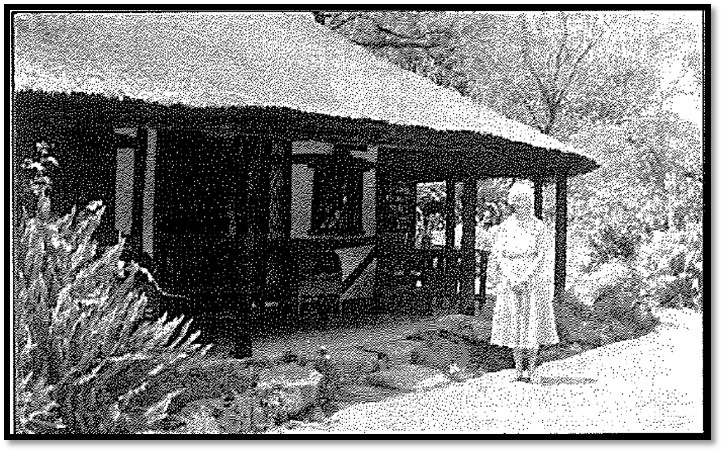
Elizabethan Cottage, Warwick Farm with Mrs Elizabeth Whaley
Then on the banks of the Hunyani river (Manyame) it covered acres 3,002 acres (1,215 hectares) and included the railway line with a siding until Lake McIlwaine was constructed and the railway line diverted north of the Hunyani Range.
Sublime Farm and United Farm and Kent Estates
Soon South was on the lookout for additional farmland within a 50 mile (80 km) radius of Salisbury as he wanted to be near the town’s market and railhead and was often seen scouting around in his usual mode of transport, a trap and two horses. In 1905 three additional neighbouring farms were purchased, one being Sublime Farm to the north of Warwick Farm and also named on the above map.
Sublime cigarettes and pipe tobacco
South even set up a tobacco factory on Sublime Farm and started producing Turkish and Virginia cigarettes and pipe tobacco both for the local and export markets marketed under the ‘Sublime’ name. When he wrote his article Rice stated that the building was still visible on Sublime Farm. From the start the entire tobacco crop grown on Kent Estates was sent over to Warwick home Farm and after flue curing went to Sublime Farm and the tobacco factory where it was processed into cigarettes and pipe tobacco and sold under the label of “Sublime Smoking Mixture.”
This extraordinary man broke away from the idea that only imported American tobacco seed could be used locally and developed his own variety called “South Seed” that was soon supplying most of the early tobacco growers in the country.

South’s tobacco seed (L) and Sublime pipe tobacco (R)
Kent Estates
Kent Estates comprised a block of 22,000 acres (8,903 hectares) on the eastern bank of the Hunyani (Manyame) river between the Harare-Bulawayo Highway (A5) and Lake Chivero that South named Kent Estates after his home county in England. He had been very taken by this picturesque part of the country with its northern slopes leading upwards to the Hunyani Range. The western end of Kent Estates where it butted against the present-day Morton Jaffray Water Treatment Works was where Joseph Norton, his wife and child, Ms Fairweather and farm managers James Alexander and Harry Gravenor were all murdered on 17 June 1896 at the start of the Mashona Rebellion (First Chimurenga)
Development soon started and the hard work of clearing the land and stumping trees, building pole and dhaka thatched bachelor quarters for the staff and manager of Kent Estates, the first being a Mr Odlum.[1]
They began to grow experimental crops of Virginia tobacco with some success and constructing experimental tobacco curing barns.
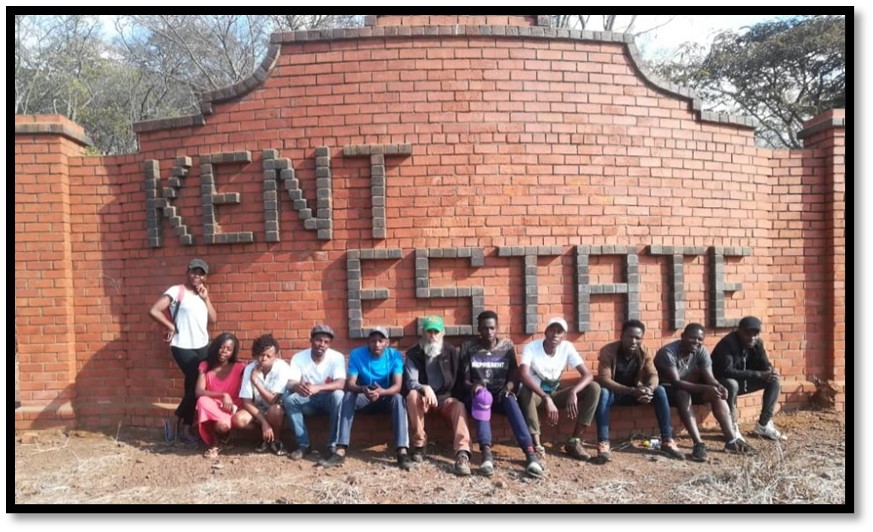
Kent Estates from a 2019 photo taken from the BirdLife Zimbabwe website
In 1907 twenty acres of Virginia tobacco were grown under irrigation with great success and each year the acreage was increased with Kent Estates being probably one of the first large-scale attempts at growing a Virginia tobacco crop in Southern Rhodesia.
The Ivel Agricultural Motor No 141
South imported the Ivel because in 1902-3 there was an outbreak of East Coast fever that had crossed the Zambesi river from the north and draught oxen were almost unobtainable. A detailed article on the Ivel Agricultural Motor The 1903 Ivel Agricultural Motor No 141 in the Mutare Museum; one of only seven that still exist today is listed under Manicaland province on the website www.zimfieldguide.com
This tractor was exhibited at the World Ploughing Contest held at Kent Estates in April 1968.
In 1904 the first mechanical tobacco planter was imported into the country by Ernest South. However it was later discarded in favour of the quicker and more efficient hand planting method.

First mechanical planter – here drawn by horses
In 1905 he made the first large scale planting of Virginia tobacco in the Norton district. This crop was grown exclusively until at least 1911. The only livestock on the farm were working oxen and their grain feed was purchased from local African farmers.
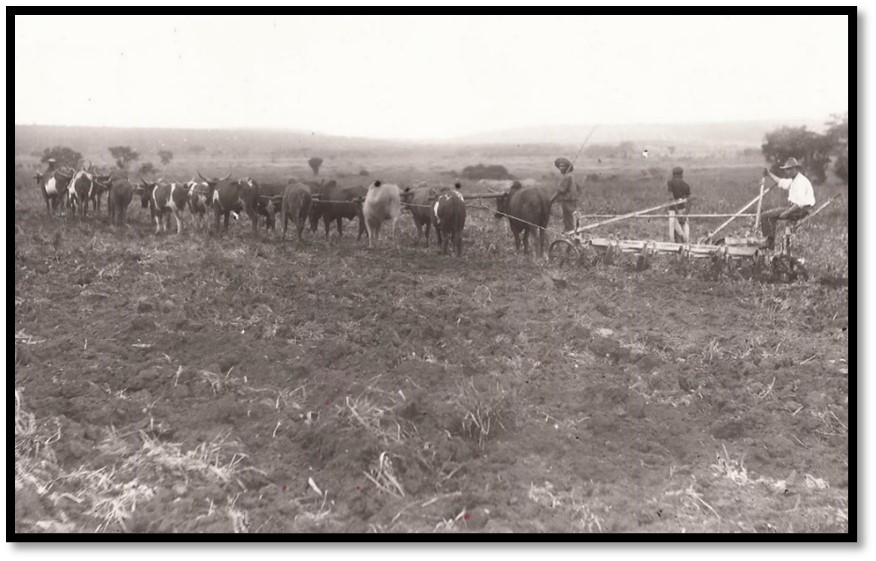
A span of 16 oxen ploughing on Warwick farm; Hunyani range possibly in the distance.
The crop was flue cured initially in pole and dhaka barns built as multiple units – a first in Southern Rhodesia, later the barns were built with sun-dried Kimberley bricks and then fired bricks under corrugated-iron roofs and this method gradually became widely-adopted throughout Mashonaland.
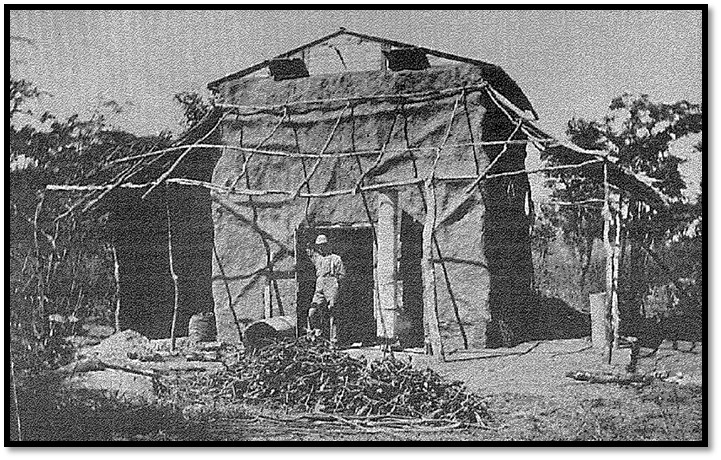
South standing in the doorway of his first barn for flue-cured Virginia tobacco
Steam powered portable engines[2] and old traction engines[3] were often used in subsequent years to provide the steam to raise the temperature for the tobacco barn curing process as seen below.

Author photo; old portable engine providing steam for curing tobacco – Centenary District
The curing barns were built alongside the tobacco lands to minimise handling. Where the tobacco did need transporting ox drawn sleds were used for the most part.
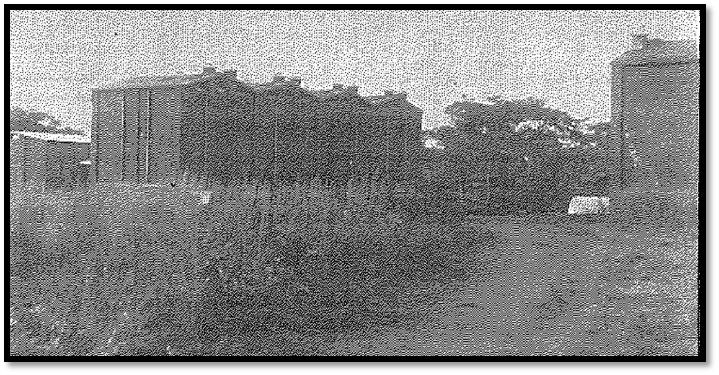
Multiple brick tobacco curing barns on Kent Estates in 1907
Hunyani Rhodesia Tobacco Plantation Company goes bust
In 1911 the company which had brought him out to Southern Rhodesia went bankrupt and Ernest South returned to England for a time. There he married Mary and brought her back to this country on the condition that he built her the Elizabethan-style cottage that she demanded!
He reopened Sublime, United and Warwickshire Farms and gradually bought them from his former bankrupt company growing tobacco on an increasing acreage. Kent Estates was sold in 1911.
Later years
However by 1926 the tobacco market had taken a serious downturn and South gave up tobacco altogether to concentrate his considerable energies on developing maize varieties that were appropriate for local conditions. This became an absorbing life-long passion and he lived on Warwick Farm for 64 years. He started cross-breeding maize varieties and produced an open pollinated variety that he called “Southern Cross” and experimented with hybridisation.
His daughter Elizabeth always remembered her father in his workshop constantly experimenting and trying to develop new ideas. His aim was always to farm more efficiently.
Ernest South died in 1965, aged ninety-two years old, still bright and energetic until the end.

Ernest and Mary South Ernest South on horseback
References
Vernie Rice. The Kent Story Part 1. Nexus Magazine
Inventor / Farmer E.H. South. Zimbabwe Tobacco Association Magazine. Vol 1, No 3, March 1992, P29-32
Notes
[1] Kent Estates appears today to be thriving even today as one of five agricultural and poultry units operating as Ariston Holdings Limited
[2] There is a Ruston and Hornsby portable engine in the article Kadoma (formerly Gatooma) Steam Centre under Mashonaland West on the website www.zimfieldguide.com
[3] See the articles about the 1896 Bow McLachlan Traction Engine / Road Locomotive in the Mutare Museum under Manicaland, the article The Charles Burrell Steam Traction Engine / Road Locomotive under Harare, and the article Halfway House Agricultural Machinery under Manicaland – all on the website www.zimfieldguide.com
When to visit:
n/a
Fee:
n/a
Category:
Province:
